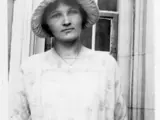Step 1:
Make a ball 1 inch wide to be the Earth and a ball 1/4 inch wide to be the Moon. Gently stick a toothpick into each ball.
Step 2:
Take your yardstick or dowel, and attach the Earth model to one end with a binder clip.
Step 3:
Measure 30 inches away from the Earth ball using your yardstick or measuring tape, and attach the Moon ball there with the other binder clip. Your model now represents the average distance between the Earth and Moon if they were this size.
Step 4:
Take your model outside on a sunny day, or have someone shine a flashlight toward you.
Hold the model so the stick points toward the Sun or flashlight, with the Moon ball closer to the light, and try to line up the Earth ball so that the Moon’s tiny shadow lands on it.
Don't worry if it takes time to do this. It’s difficult!
Think About It!
Even though the real Earth and Moon feel pretty big to us, they are much smaller than the space between them, and they very rarely line up with the Sun exactly.
That’s why we only see eclipses a few times per year.



























